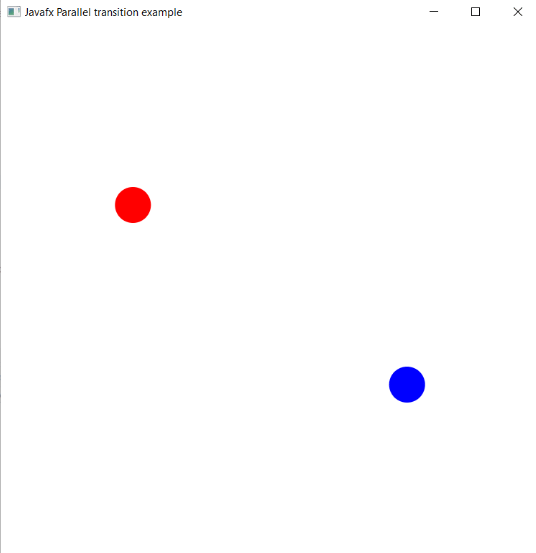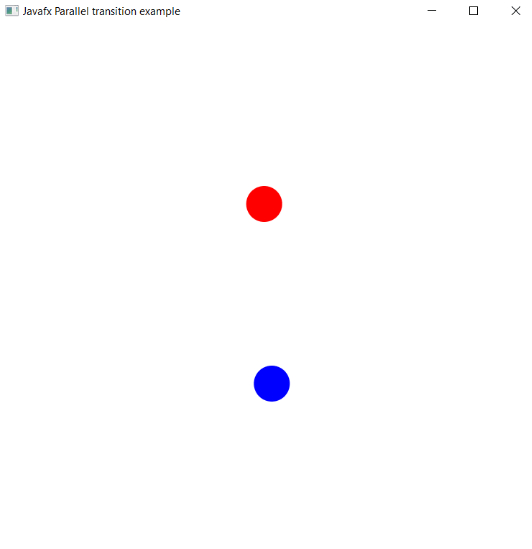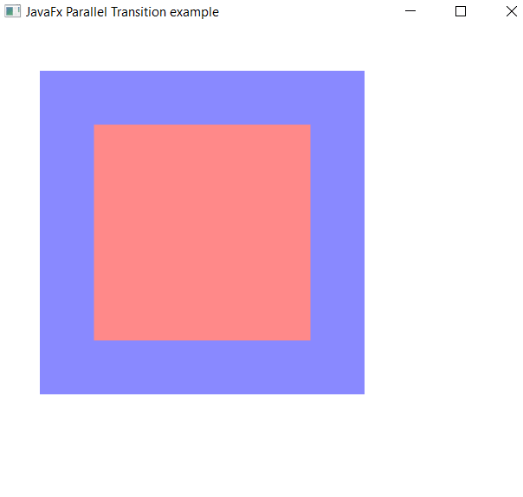JavaFX Parallel Transition
In the JavaFX application, in order to generate the parallel transition, we have to apply parallel transition on any particular shape. It has the ability to execute multiple transactions parallelly. All methods needed for this purpose are present in the javafx.animation.ParallelTransition class.
JavaFX Animation - Parallel Transition
Example:
import javafx.animation.Interpolator;
import javafx.animation.ParallelTransition;
import javafx.animation.Transition;
import javafx.application.Application;
import javafx.scene.Group;
import javafx.scene.Scene;
import javafx.scene.paint.Color;
import javafx.scene.shape.Circle;
import javafx.stage.Stage;
import javafx.util.Duration;
public class AnimationUI extends Application {
@Override
public void start(Stage stage) throws Exception
{
Circle newball1 = new Circle(0,0,20);
newball1.setFill(Color.RED);
Circle newball2 = new Circle(0,0,20);
newball2.setFill(Color.BLUE);
Group root = new Group();
root.getChildren().addAll(newball1, newball2);
Scene scene = new Scene(root, 600, 600);
stage.setScene(scene);
stage.setTitle("Javafx Parallel transition example");
stage.show();
TranslateTransition newt1 = new TranslateTransition(
Duration.millis(2000), newball1);
newt1.setFromX(newball1.getRadius());
newt1.setToX(scene.getWidth() - newball1.getRadius());
newt1.setFromY(scene.getHeight() / 3);
newt1.setToY(scene.getHeight() / 3);
newt1.setCycleCount(Transition.INDEFINITE);
newt1.setAutoReverse(true);
newt1.setInterpolator(Interpolator.LINEAR);
TranslateTransition newt2 = new TranslateTransition(
Duration.millis(2000), newball2);
newt2.setFromX(scene.getWidth() - newball2.getRadius());
newt2.setToX(newball2.getRadius());
newt2.setFromY(scene.getHeight() / 3 * 2);
newt2.setToY(scene.getHeight() / 3 * 2);
newt2.setCycleCount(Transition.INDEFINITE);
newt2.setAutoReverse(true);
newt2.setInterpolator(Interpolator.LINEAR);
ParallelTransition pt = new ParallelTransition(newt1, newt2);
pt.play();
}
public static void main(String[] args) {
launch(args);
}
}
Output:
In order to create the parallel Transition in JavaFX, we have to import all the required libraries such as javafx.animation.TranslateTransition, javafx.animation.ParallelTransition, javafx.animation.PauseTransition, javafx.application.Application, javafx.scene.Group, javafx.scene.Scene, javafx.scene.paint.Color, javafx.scene.shape.Circle, javafx.stage.Stage, javafx.util.Duration.
Then we have created one class named AnimationUI extending the Application class. Also, we have to override the start method to provide implementation details. This method creates an object of Stage as primaryStage. For the container to hold a parallel transition on balls, a Group object is created which is then passed to the Scene class object.
The circle is created with the help of the constructor and the size parameter and red and blue color to be filled are passed in it. A Parallel Transition object is created and using setters various properties are set. Then it will show parallel transitions on circle shaped balls.
The stage is prepared, the title is set and the show() method is called to display output. In order to run the application, the launch(args) method is called in the main() method. In output Frame like container is displayed with the title, " JavaFX Parallel Transition Example”. Also, it displays one red and one blue ball translating from one place to another simultaneously.


JavaFX Animation - Parallel Transition
Example:
import javafx.animation.FadeTransition;
import javafx.animation.ParallelTransition;
import javafx.animation.ScaleTransition;
import javafx.animation.TranslateTransition;
import javafx.application.Application;
import javafx.scene.Group;
import javafx.scene.Scene;
import javafx.scene.paint.Color;
import javafx.scene.shape.Rectangle;
import javafx.stage.Stage;
import javafx.util.Duration;
public class SliderUI extends Application {
@Override
public void start(Stage stage) throws Exception
{
Rectangle newcir = new Rectangle(140,140,100,100);
newcir.setStroke(Color.BLUE);
newcir.setFill(Color.RED);
newcir.setStrokeWidth(20);
Duration dur1 = Duration.millis(1000);
FadeTransition fade = new FadeTransition();
fade.setDuration(Duration.millis(3000));
fade.setFromValue(10);
fade.setToValue(0.1);
fade.setCycleCount(1000);
ScaleTransition scale = new ScaleTransition(dur1);
scale.setByX(1.5f);
scale.setByY(1.5f);
scale.setAutoReverse(true);
ParallelTransition seqT = new ParallelTransition (newcir,scale, fade);
seqT.play();
Group root = new Group();
root.getChildren().addAll(newcir);
Scene scene = new Scene(root,500,450);
stage.setScene(scene);
stage.setTitle("JavaFx Parallel Transition example");
stage.show();
}
public static void main(String[] args) {
launch(args);
}
}
Output:
In order to create the parallel Transition in JavaFX, we have to import all the required libraries such as javafx.animation.ScaleTransition, javafx.animation.ParallelTransition, javafx.animation.FadeTransition, javafx.application.Application, javafx.scene.Group, javafx.scene.Scene, javafx.scene.paint.Color, javafx.scene.shape.Rectangle, javafx.stage.Stage, javafx.util.Duration.
Then we have created one class named AnimationUI extending the Application class. Also, we have to override the start method to provide implementation details. This method creates an object of Stage as primaryStage. For the container to hold a parallel transition on the rectangle, a Group object is created which is then passed to the Scene class object.
The rectangle is created with the help of the constructor and the size parameter and red color to be filled are passed in it. A Parallel Transition object is created and using setters various properties are set. Then it will show parallel transitions on the rectangle.
The stage is prepared, the title is set and the show() method is called to display output. In order to run the application, the launch(args) method is called in the main() method. In output Frame like container is displayed with the title, " JavaFX Parallel Transition Example”. Also, it displays one rectangle scaling and fading simultaneously.
